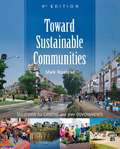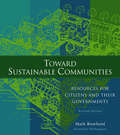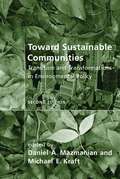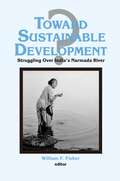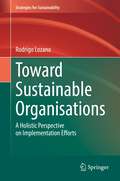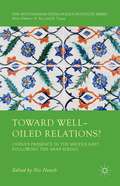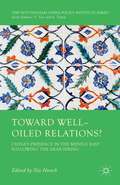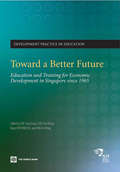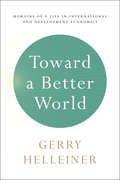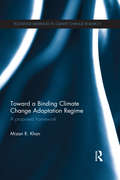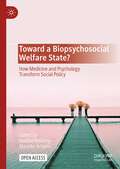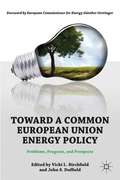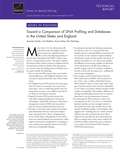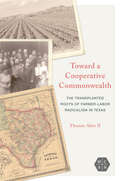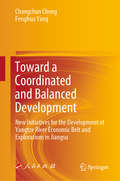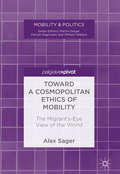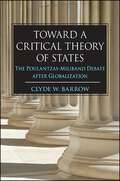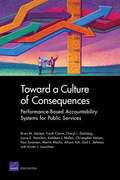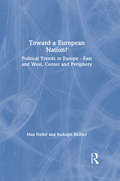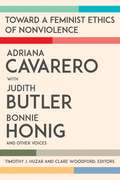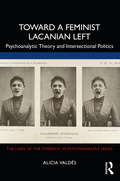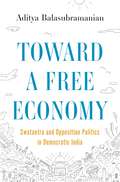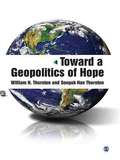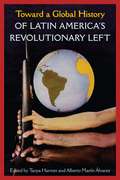- Table View
- List View
Toward Sustainable Communities
by Mark RoselandThe need to make our communities sustainable is more urgent than ever before. Toward Sustainable Communities remains the single most useful resource for creating vibrant, healthy, equitable, economically viable places. This comprehensive update of the classic text presents a leading-edge overview of sustainability in a new fully illustrated, full-color format.Compelling new case studies and expanded treatment of sustainability in rural as well as urban settings are complemented by contributions from a range of experts around the world, demonstrating how "community capital" can be leveraged to meet the needs of cities and towns for:*Energy efficiency, waste reduction, and recycling*Water, sewage, transportation, and housing*Climate change and air quality*Land use and urban planning.Fully supported by a complete suite of online resources and tools, Toward Sustainable Communities is packed with concrete, innovative solutions to a host of municipal challenges. Required reading for policymakers, educators, social enterprises, and engaged citizens, this "living book" will appeal to anyone concerned about community sustainability and a livable future.Mark Roseland is director of the Centre for Sustainable Community Development at Simon Fraser University and professor at SFU's School of Resource and Environmental Management. He lectures internationally, advises communities and governments on sustainable development policy and planning, and has been cited as one of British Columbia's "top fifty living public intellectuals."
Toward Sustainable Communities
by Stacy Mitchell Mark RoselandLocal governments are increasingly caught between rising expectations that development initiatives be sustainable and the fact that more and more services are being downloaded to the municipal level. The third edition of this classic text offers practical suggestions and innovative solutions to a range of community problems---including energy efficiency, transportation, land use, housing, waste reduction, recycling, air quality and governance. In clear language, with updated tools, initiatives and resources, a new preface and foreword, this sustainable practices resource is for both citizens and governments.Mark Roseland is director of the Centre for Sustainable Community Development at Simon Fraser University in British Columbia. He lectures internationally and advises communities and governments.
Toward Sustainable Communities: Transition and Transformations in Environmental Policy (American and Comparative Environmental Policy)
by Michael E. Kraft Daniel A. Mazmanian D. Mazmanian<p>A new edition with new and updated case studies and analysis that demonstrate the trend in U.S. environmental policy toward sustainability at local and regional levels. <p>This analysis of U.S. environmental policy offers a conceptual framework that serves as a valuable roadmap to the array of laws, programs, and approaches developed over the last four decades. Combining case studies and theoretical discussion, the book views environmental policy in the context of three epochs: the rise of command-and-control federal regulation in the 1970s, the period of efficiency-based reform efforts that followed, and the more recent trend toward sustainable development and integrated approaches at local and regional levels. It assesses the strengths and weaknesses of the new approaches and places these experiments within the larger framework of an emerging trend toward community sustainability. <p>Toward Sustainable Communities assesses environmental policy successes and failures at the subnational, regional, and state levels and offers eight case studies of policy arenas in which transformations have been occurring―from air and water pollution control and state and local climate change policy to open space preservation, urban growth, and regional ecosystem management. It discusses the various meanings of sustainability and whether the concept can serve as a foundation for a new era of environmental policy. The second edition has been substantially updated, with five new chapters (including the chapter on climate change) and all other chapters revised and shortened. It is suitable as a primary or secondary text for environmental policy courses and as a resource for scholars and policymakers.</p>
Toward Sustainable Development?: Struggling Over India's Narmada River
by Ronald C FisherAn interdisciplinary case study of a project to dam the Narmada River in central and western India so that it can be used productively. Diverse opinions of proponents and opponents are expressed, as are studies on human rights of disadvantaged groups displaced by the work.
Toward Sustainable Organisations: A Holistic Perspective on Implementation Efforts (Strategies for Sustainability)
by Rodrigo LozanoThe book is one of the first ones focussing on how organisations (civil society, corporations, and public sector ones) are contributing to sustainability. The book starts by providing a discussion of the four dimensions of sustainability (economic, environmental, social, and time). The second chapter focusses on what organisations are, their system elements (e.g. operations and production, management and strategy, and governance), stakeholders, relationships within and between organisations (ranging from competition to collaboration), and a framework for organisations to understand and map how they can contribute to sustainability. The third chapter discusses the twenty-four main tools, initiatives, and approaches (TIAs) that have been developed for organisations to contribute to sustainability, such as Circular Economy, Corporate Social Responsibility, Environmental Management Systems, and Sustainability Reporting. The fourth chapter focusses on organisational change management for sustainability, including types of change, drivers for change, resistance to change, incorporation, and institutionalisation. The fifth chapter presents empirical evidence on what civil society organisations have contributed to sustainability, from priorities and impacts, TIAs, external stimuli, and internal factors, drivers for change, starts of change, and development of change. The sixth chapter presents empirical evidence on what corporations have contributed to sustainability, from priorities and impacts, TIAs, external stimuli, and internal factors, drivers for change, starts of change, and development of change. The seventh chapter presents empirical evidence on what public sector organisations have contributed to sustainability, from priorities and impacts, TIAs, external stimuli, and internal factors, drivers for change, starts of change, and development of change. The last chapter provides the conclusions of the book.The book is aimed at providing a multi-level, dynamic, and holistic perspective on the contributions of organisations to sustainability. The book's uniqueness lies in analysing organisations’ efforts to become more sustainability oriented and contribute to making societies more sustainable through systems thinking, TIAs, and change processes.
Toward Well-Oiled Relations?: China's Presence in the Middle East Following the Arab Spring (The Nottingham China Policy Institute Series)
by Niv HoreshToward Well-Oiled Relations?
Toward Well-Oiled Relations?: China’s Presence in the Middle East following the Arab Spring (The Nottingham China Policy Institute Series)
by Niv HoreshWith China replacing the United States as the world's leading energy user and net oil importer, its relations with the Middle East is becoming a major issue with global implications. Horesh and his contributors set out to analyse the implications of China's growing presence in the Middle East.
Toward a Better Future: Education and Training for Economic Development in Singapore since 1965
by Sing Kong Lee'Toward a Better Future' provides a comprehensive analysis of education development in Singapore since 1965, giving particular attention to the strategic management that has enabled Singapore to transform its education and training system from one similar to that of many Sub-Saharan African countries four decades ago into one of the world's best-performing systems. It is one of a pair of concurrently-published books presenting materials originally developed for a 2006 study tour to Singapore and Vietnam for senior education officials from Cameroon, Ethiopia, Ghana, Lesotho, Madagascar, and Mozambique. The second book, 'An African Exploration of the East Asian Education Experience', presents five country studies, as well as regional, comparative analyses highlighting insights gained during the study tour and putting them in the context of Sub-Saharan Africa. Together, the two books aim to foster knowledge exchange between Sub-Saharan African and East Asian countries on good practices in the design and implementation of education policies and programs. By facilitating the cross-country fertilization of ideas between two regions with relatively limited contact in the past, these books fi ll a clear gap in the current literature on development practice in education.
Toward a Better World: Memoirs of a Life in International and Development Economics
by Gerald Gerry HelleinerTowards a Better World describes the life, times and perspectives of Gerry Helleiner, a Canadian activist and university-based economist, who worked for roughly 40 years with developing countries and international organizations. In his memoir, Towards a Better World, Helleiner, recounts the profound early experiences in Africa that propelled him into a rewarding career devoted to research, advice and teaching in international economics, economic development and global poverty reduction. Describing himself as privileged, Towards a Better World recounts his early life as a young academic, having first landed in Africa in the 1960s for the purpose of research for Yale University. Detailing both successes and setbacks, frustrations and hopes, Helleiner, conveys his often difficult, yet transformative, experiences in Nigeria and Tanzania, missions in Uganda and South Africa, and witnesses the wavering efforts being made towards poverty alleviation in international organisations . Providing lively behind-the-scene accounts of multilateral economic meetings in the 1970s through the 1990s, Helleiner addresses his engagement with economic policymakers, his views often challenging common practice. In Towards a Better World, Helleiner speaks to his early motivation as a young man in Africa, and his lifework as a practicing economist determined to make a positive effort in addressing global poverty.
Toward a Binding Climate Change Adaptation Regime: A Proposed Framework (Routledge Advances in Climate Change Research)
by Mizan R. KhanFirst published in 2014. Routledge is an imprint of Taylor & Francis, an informa company.
Toward a Biopsychosocial Welfare State?: How Medicine and Psychology Transform Social Policy
by Mareike Ariaans Nadine ReiblingThis open access book analyses the idea that medicine and psychology have a substantial (and underestimated) impact on Western welfare states. Based on mixed-methods analyses conducted in Germany, it analyses this influence on debates and policies related to unemployment, poverty, and childhood. The book demonstrates how the turn to neoliberalism and social investment thinking has created this medicalisation and psychologisation of social policies, and the contributions provide important insights for students and scholars of sociology of health and illness, political sociology, social and health policy, medicine, psychology, and public health.
Toward a Common European Union Energy Policy: Problems, Progress, And Prospects
by Vicki L. BirchfieldSince the mid-2000s, the European Union has made unprecedented strides toward the creation of a common energy policy. This book takes stock of these developments, evaluating how much progress has actually been made and what remains to be done, what factors explain these recent advances and their limitations.
Toward a Comparison of DNA Profiling and Databases in the United States and England
by Carl Matthies Paul Steinberg Emma Disley Jeremiah GoulkaRAND researchers explored the U.S. and English forensic DNA analysis systems to find out whether England has capitalized more fully on their crime-fighting potential than the U.S. system, processing samples more quickly and providing more database hits for law enforcement.
Toward a Cooperative Commonwealth: The Transplanted Roots of Farmer-Labor Radicalism in Texas (Working Class in American History)
by Thomas AlterAgrarian radicalism's challenge to capitalism played a central role in working-class ideology while making third parties and protest movements a potent force in politics. Thomas Alter II follows three generations of German immigrants in Texas to examine the evolution of agrarian radicalism and the American and transnational ideas that influenced it. Otto Meitzen left Prussia for Texas in the wake of the failed 1848 Revolution. His son and grandson took part in decades-long activism with organizations from the Greenback Labor Party and the Grange to the Populist movement and Texas Socialist Party. As Alter tells their stories, he analyzes the southern wing of the era's farmer-labor bloc and the parallel history of African American political struggle in Texas. Alliances with Mexican revolutionaries, Irish militants, and others shaped an international legacy of working-class radicalism that moved U.S. politics to the left. That legacy, in turn, pushed forward economic reform during the Progressive and New Deal eras. A rare look at the German roots of radicalism in Texas, Toward a Cooperative Commonwealth illuminates the labor movements and populist ideas that changed the nation’s course at a pivotal time in its history.
Toward a Coordinated and Balanced Development: New Initiatives for the Development of Yangtze River Economic Belt and Explorations in Jiangsu
by Changchun Cheng Fenghua YangThe book is a comprehensive study of the strategic position of Yangtze River Economic Belt in the political and economic development of China. It is a holistic and precise qualitative and quantitative delineation of Jiangsu’s position in this belt and its development strategy, and the strategic position of Yangtze River Economic Belt in national development. It also illustrates the great significance of the initiation of Yangtze River Economic Belt for the economy, politics, environment, and integration of natural resources. There is a research of the position of Jiangsu in the construction of the nation, and the difficulties it has encountered. Coordinated and balanced development of Yangtze River Economic Belt will effectively facilitate reasonable allocation and exploitation of various resources, the implementation of other national strategies, and communication and cooperation between China and Western countries, enhancing their mutual understanding. Therefore, common readers can get some general information from different perspectives, and professionals can have a detailed understanding of different arrangements and guiding principles. It is thus suitable for different readers.Yangtze River Economic Belt runs through the three regions of China, making a vital latitudinal axis, whose coordinated and balanced development is of great strategic importance for promoting coordinated and shared development of the three regions and for the spatial balance of population, economy and the environment. The current imbalance between them, the absolute disparity in regional development, the obstruction in the flow of resource factors, the inequality in development opportunities, the incoordination between regional economic growth and the bearing capacity of resources and environment, the fragmentation of regional economic policies, all contribute to the insufficient utilization of the Golden Waterway, problems numerous. How coordinated and balanced development can be realized within this economic belt is a prominent and pressing, even a severe problem.
Toward a Cosmopolitan Ethics of Mobility: The Migrant's-Eye View of the World (Mobility & Politics)
by Alex SagerThis book proposes a cosmopolitan ethics that calls for analyzing how economic and political structures limit opportunities for different groups, distinguished by gender, race, and class. The author explores the implications of criticisms from the social sciences of Eurocentrism and of methodological nationalism for normative theories of mobility. These criticisms lend support to a cosmopolitan social science that rejects a principled distinction between international mobility and mobility within states and cities. This work has interdisciplinary appeal, integrating the social sciences, political philosophy, and political theory.
Toward a Critical Theory of States: The Poulantzas-Miliband Debate after Globalization (SUNY series in New Political Science)
by Clyde W. BarrowWe have recently lived through the turmoil of a global financial crisis that originated in the United States and, despite the platitudes of neo-liberal ideology, nation-states were deeply involved in managing this crisis. If "the state" is again a preeminent actor in the global economy, then state theory and the problem of the state should also return to the forefront of political theory. Toward a Critical Theory of States is an intensive analysis of the 1970s debate between state theorists Ralph Miliband and Nicos Poulantzas, including its wider impact on Marxist theories of the state in subsequent decades. Clyde W. Barrow makes unique arguments and contributions to this continuing discussion in state theory and lays the foundation for more theoretically informed empirical and historical research on the state in the age of globalization. He argues that by merely moving past the Poulantzas-Miliband debate, as some have recommended, scholars have abandoned much that is valuable in understanding the state, particularly the need to comprehend the contemporary transformation of the state form and the state apparatuses as part of the new conditions of globalization and transnational capital accumulation. Building upon themes of state restructuring found in Poulantzas and Miliband, Barrow establishes the outlines of an approach that integrates the thought of both to propose a synthetic understanding of the new imperialism.
Toward a Cultural Politics of Climate Change: Devices, Desires and Dissent
by Johannes Stripple Harriet Bulkeley Matthew PatersonTowards a Cultural Politics of Climate Change provides a new perspective on how climate change matters in policy-making, business and everyday life. It argues that the work of low carbon transitions takes place through the creation of devices, the mobilisation of desires, and the articulation of dissent. Using case studies from the US, Australia, and Europe, the book examines the creation and contestation of new forms of cultural politics - of how a climate-changed society is articulated, realized and contested. Through this approach it opens up questions about how, where and by whom climate politics is conducted and the ways in which we might respond differently to this societal challenge. This book provides a key reference point for the emerging academic community working on the cultural politics of climate change, and a means through which to engage this new area of research with the broader social sciences. Develops a new framework for analyzing the cultural politics of climate change, providing readers with a new perspective that bridges accounts of cultural responses to climate change and those which focus on its politics. Includes a range of international case studies which demonstrate the ways in which responses to climate change are being realized in everyday life, giving readers concrete examples from familiar areas of social and political life through which to interpret the new perspective. Provides a new approach to thinking about how climate change comes to matter in everyday life, for those seeking to look beyond 'individualist' approaches to understanding how society is responding to climate change.
Toward a Culture of Consequences
by Brian M. Stecher Frank Camm Cheryl L. Damberg Laura S. Hamilton Kathleen J. MullenPerformance-based accountability systems (PBASs) link incentives to measured performance to improve services to the public. Research suggests that PBASs influence provider behaviors, but little is known about PBAS effectiveness at achieving performance goals. This study examines nine PBASs that are drawn from five sectors: child care, education, health care, public health emergency preparedness, and transportation.
Toward a European Nation?: Political Trends in Europe - East and West, Center and Periphery
by Max HallerThis text presents the work of scholars from all over Europe who examine processes of integration and disintegration at the level of nation states, federations, regions and Europe overall.
Toward a Feminist Ethics of Nonviolence
by Judith Butler Bonnie Honig Adriana CavareroToward a Feminist Ethics of Nonviolence brings together major feminist thinkers to debate Cavarero’s call for a postural ethics of nonviolence and a sociality rooted in bodily interdependence.Toward a Feminist Ethics of Nonviolence brings together three major feminist thinkers—Adriana Cavarero, Judith Butler, and Bonnie Honig—to debate Cavarero’s call for a postural ethics of nonviolence. The book consists of three longer essays by Cavarero, Butler, and Honig, followed by shorter responses by a range of scholars that widen the dialogue, drawing on post-Marxism, Italian feminism, queer theory, and lesbian and gay politics. Together, the authors contest the boundaries of their common project for a pluralistic, heterogeneous, but urgent feminist ethics of nonviolence.
Toward a Feminist Lacanian Left: Psychoanalytic Theory and Intersectional Politics
by Alicia ValdésWhile traditional feminist readings on antagonism have pivoted around the sole axis of sex and/or gender, a broader and intersectional approach to antagonism is much needed; this book offers an innovative, feminist, and discursive reading on the Lacanian concept of sexual position as a way to problematize the concepts of political antagonism and political subjects. Can Lacanian psychoanalysis offer new grounds for feminist politics? This discursive mediation of Lacan's work presents a new theoretical framework upon which to articulate proposals for intersectional political theory. The first part of this book develops the theoretical framework, and the second part applies it to the construction of woman’s identity in European politics and economy. It concludes with notes for a feminist political and economic praxis through community currencies and municipalism. The interdisciplinary approach of this book will appeal to scholars interested in the fields of psychoanalysis, feminisms, and political philosophy as well as multidisciplinary scholars interested in discourse theory, sexuality and gender studies, cultural studies, queer theory, and continental philosophy. Students at master's and PhD level will also find this a useful feminist introduction to Lacanian psychoanalysis, discourse, and gender.
Toward a Free Economy: Swatantra and Opposition Politics in Democratic India (Histories of Economic Life #44)
by Aditya BalasubramanianThe unknown history of economic conservatism in India after independenceNeoliberalism is routinely characterized as an antidemocratic, expert-driven project aimed at insulating markets from politics, devised in the North Atlantic and projected on the rest of the world. Revising this understanding, Toward a Free Economy shows how economic conservatism emerged and was disseminated in a postcolonial society consistent with the logic of democracy.Twelve years after the British left India, a Swatantra (“Freedom”) Party came to life. It encouraged Indians to break with the Indian National Congress Party, which spearheaded the anticolonial nationalist movement and now dominated Indian democracy. Rejecting Congress’s heavy-industrial developmental state and the accompanying rhetoric of socialism, Swatantra promised “free economy” through its project of opposition politics.As it circulated across various genres, “free economy” took on meanings that varied by region and language, caste and class, and won diverse advocates. These articulations, informed by but distinct from neoliberalism, came chiefly from communities in southern and western India as they embraced new forms of entrepreneurial activity. At their core, they connoted anticommunism, unfettered private economic activity, decentralized development, and the defense of private property.Opposition politics encompassed ideas and practice. Swatantra’s leaders imagined a conservative alternative to a progressive dominant party in a two-party system. They communicated ideas and mobilized people around such issues as inflation, taxation, and property. And they made creative use of India’s institutions to bring checks and balances to the political system.Democracy’s persistence in India is uncommon among postcolonial societies. By excavating a perspective of how Indians made and understood their own democracy and economy, Aditya Balasubramanian broadens our picture of neoliberalism, democracy, and the postcolonial world.
Toward a Geopolitics of Hope
by Songok Han Thornton William H ThorntonToward a Geopolitics of Hope posits a world order marked less by univocal "globalization" than by a grating geopolitics of rival capitalisms. Now that China, Russia, and much of the undemocratic developing world have embraced capitalism, this new Second World can no longer be regarded as a fleeting phenomenon. Globalization turns out to be anything but the steadfast ally of democratization it purports to be. Indeed, the Western democratic experiment of the last two centuries is starting to look very tentative and parochial. For this the West has nothing to blame but itself. In many respects the new Second World was spawned by First World neoliberal engagement. The Washington Consensus has not only brought the world to the brink of an intractable economic depression, but has played midwife to a chronic geopolitical crisis. Hope, however, is anything but defeatist in the face of this globalist impasse. It draws upon a host of non-Western reformisms--with special attention to those of India, Burma, and the Arab Spring--to forge a Global Third Way. Likewise its moral realism bridges the classic imperatives of Third World social justice and First World security. Its paramount goal is not just a new "soft power" politics, but a post-globalist geopolitics of hope.
Toward a Global History of Latin America’s Revolutionary Left
by Tanya Harmer and Alberto Martín ÁlvarezThis volume showcases new research on the global reach of Latin American revolutionary movements during the height of the Cold War, mapping out the region’s little-known connections with Africa, Asia, and Europe. Toward a Global History of Latin America’s Revolutionary Left offers insights into the effect of international collaboration on the identities, ideologies, strategies, and survival of organizers and groups.Featuring contributions from historians working in six different countries, this collection includes chapters on Cuba’s hosting of the 1966 Tricontinental Conference that brought revolutionary movements together; Czechoslovakian intelligence’s logistical support for revolutionaries; the Brazilian Left’s search for recognition in Cuba and China; the central role played by European publishing houses in disseminating news from Latin America; Italian support for Brazilian guerrilla insurgents; Spanish ties with Nicaragua’s revolution; and the solidarity of European networks with Guatemala’s Guerrilla Army of the Poor.Through its expansive geographical perspectives, this volume positions Latin America as a significant force on the international stage of the 1960s and 1970s. It sets a new research agenda that will guide future study on leftist movements, transnational networks, and Cold War history in the region. Contributor:s José Manuel Ágreda Portero | Van Gosse | James G. Hershberg | Gerardo Leibner | Blanca Mar León | Eduardo Rey Tristán | Arturo Taracena Arriola | Michal Zourek
